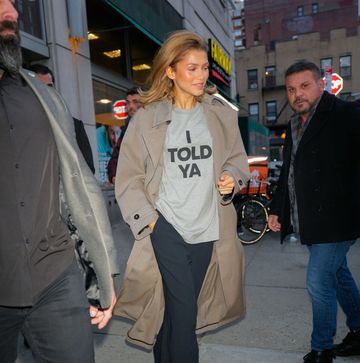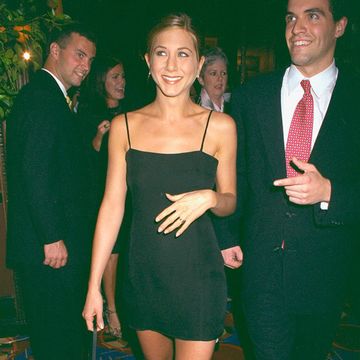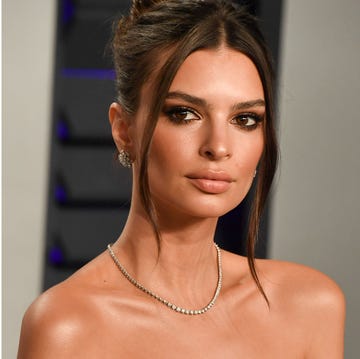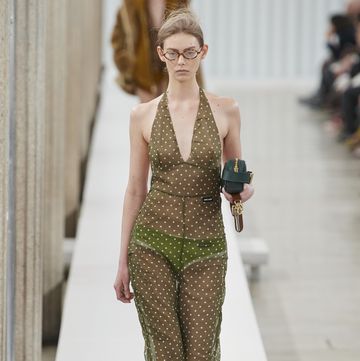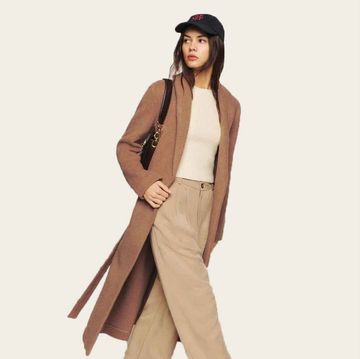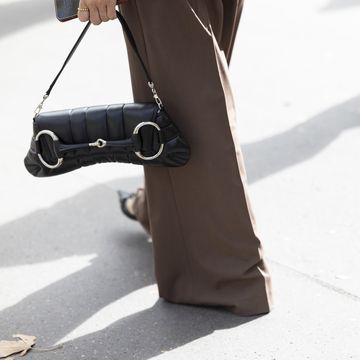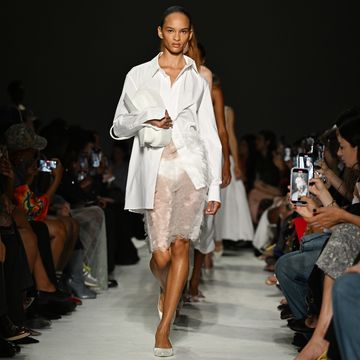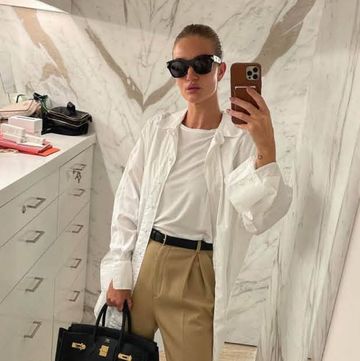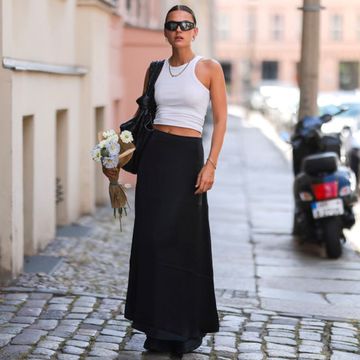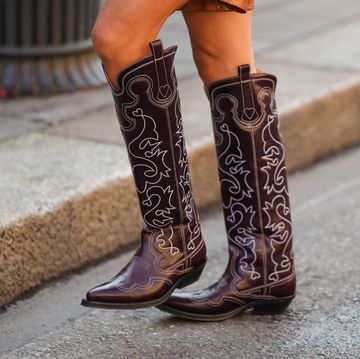Jacob Samuels' mother was the first person to ask. She wanted his opinion on a couple of dresses she could wear to his July 23rd wedding to his husband Sloan Danenhower at the Old Lyme Beach Club in Old Lyme, Conn. As she described the dress that most caught her eye—it was a white or ivory dress with a lacy pattern to it—it seemed as if she almost immediately regretted bringing it up, Samuels says.
"She said something like, 'Will I look too bridey? I don't want to give that impression. I won't even go with it,'" Samuels says.
At least five more female guests broached the subject of wearing white. It was a surprising and unexpected question that neither Samuels nor his husband Sloan thought about when planning the details for their wedding day.
"Because they knew it wasn't a bride and a groom getting married, they weren't sure how to approach what normally would be a definite no," he says. "If it had been me and a woman...a [female guest] would never had dared to wear a white dress."
The cardinal rule of wedding etiquette in Western culture is that guests, particularly female guests, shouldn't wear white to someone else's wedding. The color is reserved for the bride, a tradition established by England's Queen Victoria in the late 19th century.
Wedding dresses weren't always white. Brides said "I do" wearing the nicest dress they owned, often something they'd wear again. It wasn't until Queen Victoria wore a white gown when she married Prince Albert in 1840 that the color became synonymous with weddings. And though white represents purity, when Victoria wore it, white was a sign of wealth. Dresses then were washed by hand, rendering a white gown a laborious task and something that would probably be worn only once. Still, it was as if the public took the Queen's choice as a royal decree, making white the most fitting hue for a bride.
But remove the bride from the equation, and the question becomes as innocent as the symbolism of the color itself: Can a woman wear white to a wedding when there's no bride?
"My answer is not so fast, ladies," says Steven Petrow, a contributing columnist on etiquette and manners for The Washington Post. "Here, you have a whole different set of characters, but you have the same rule: You don't want to take the spotlight away from the two grooms getting married."
Since the 2015 Supreme Court ruling on marriage equality in the U.S., 10.2 percent of LGBTQ couples have tied the knot. As public opinion and support for same-sex marriages have changed, so, too, has the story about what a same-sex wedding should look like.
Structurally speaking, same-sex weddings are similar to heterosexual weddings in many ways: They have the same engagement period, they cost about the same, they track closely in terms of number of guests, and, in some cases, they may have some nitpicky mothers and relatives to consider. Yet wherever gender expression is involved is where many same-sex couples take their own paths, experts say.
A 2016 NewlyWed report done by WeddingWire shows that for gay male couples, less than 10 percent of men wear white—most strongly associated with a bridal gown—on their wedding day. In spite of that statistic, female guests still shouldn't be so quick to dismiss the rule; rather than assume, it's always better to ask the couple, which is exactly what Vittoria Caproni did when she was invited to a gay wedding in the summer of 2015.
Caproni had a white dress she bought on sale at Zara that had been sitting in her closet unworn for nearly a year. She didn't buy it with any particular event in mind, and she found it difficult to wear often: It was a structured dress with a tulip skirt and open back. It was dressier than a sundress but too dressy for work or a summer barbecue, and it certainly wasn't something she felt she could wear to an engagement party or a bridal shower. Then, she and her husband were invited to her husband's childhood best friend's wedding in Washington, D.C.
"I was dying to wear this dress, and I figured...man and man getting married, there's no dress to compete with," Caproni says. Nevertheless, Caproni wanted to air on the safe side and ask the groom. It was a destination wedding, and so she packed a few different options. The morning of, while the groom was in her hotel room, Caproni popped the question: Which dress should she wear?
"He looked at both dresses and said, 'Ain't no bride here, honey! You can wear whatever you want,'" she says.
Letting their guests decide is exactly what Kevin Korney and Juan Villaseñor took when fielding the question in the months leading to their Dallas-based wedding this past spring. The city's typical 70-degree April weather certainly allowed for women to wear white dresses, but tradition did not. While Korney's friends messaged him to ask him—"Will either of you be wearing white? Is it okay if I wear it?"—Villaseñor learned his friends were discussing amongst themselves, with some of them shocked a woman would even consider the thought.
"Even if the grooms don't mind, the mothers, grandmothers, sisters or any other guest could find it offensive or tacky," says Carlo Ramirez, one of Korney and Villaseñor's guests. "Just like you wouldn't wear a yellow dress to a funeral."
It's not just guests who see it as an etiquette breach. For some grooms, the rule is as black and, well, white at a gay wedding as it is at a hetero-wedding. Yuval David and his husband, Mark McDermott, planned a beach wedding at an all-inclusive resort in Riviera Maya, Mexico. David recalls his friend calling him to tell him about the perfect dress she found for his wedding: It was a light and airy white dress, perfect for his ceremony and still fabulous enough that she could wear it to a more formal event.
The curiosity bubbled up among other guests, with eight to 10 women asking whether they could wear white or off-white, David says. The color was largely out of the question, as he and his husband both wore white suits.
"When it comes to gay, same-sex weddings, many people assume...men will just wear the traditional dark suits," David says. But for David and his husband, the beauty behind the color white, its connection to a place of purity, and its role in distinguishing a couple on their big day is something special, he says, and a reason they wanted to be the only ones in full-white ensembles.
A small number of couples agreed, with some going so far as to say that whether they wear white suits or tuxedos is a moot point; a guest in white still runs the risk of stealing attention away from the couple—unless, of course, the grooms request it.
As it turns out, while some grooms are answering 'yes' or 'no,' others are the ones asking the question, particularly to guests who are part of the celebration in a significant way.
When Blake Ballard and his husband were preparing for their August 2015 nuptials in Albany, New York, Ballard wanted his sister, who would be the officiant, to wear a long white dress.
By Ballard's recollection, his sister seemed slightly surprised by the request: "That's not weird for you?" he remembers her asking. He didn't even think twice about how it might be interpreted, he says. In fact, he thought it would be a fun play off the tradition.
So, too, did Chrys Kefalas see an opportunity to bring tradition, particularly that of his Greek heritage, to his wedding with radio host Tommy McFly. Kefalas proposed the idea of asking their groom attendants, three of whom were women, to wear white dresses.
"I went back to the traditional routes that I knew to guide me on where the wedding was going, both in terms of the ceremony and of the look."
While the faux pas may not be as clearly defined of an etiquette breach in gay male weddings as it is in opposite sex weddings, the question itself represents a bigger narrative around the changing traditions and customs of wedding cultures, particularly with gay weddings.
"With planning a gay wedding, there isn't a script to pull or a playbook that says you need to adhere to this particular set of traditions, so everything is really up in the air," Kerfalas says. "Everything is a clean slate."


